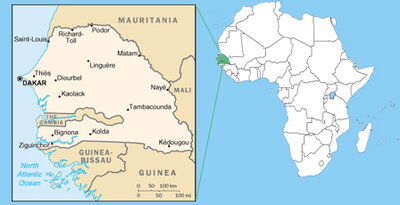

Region: Western Africa
Quick Facts:
- Population: 11.658 million
- Capital: Dakar (also the largest city)
- Area: 75,955 sq miles (Comparable to the size of South Dakota)
- Major Languages: French, Wolof
- Life Expectancy: 55.34 years (men), 58.09 years (women)
- Literacy: 39.3%
- Monetary unit: 1 CFA (Communaute Financiere Africaine) franc = 100 centimes
- Exchange Rate: US $1= 479 CFA franc (January 10, 2009)
- Income (GDP) per capita: $710 (constant 2000 international $, WDI 2005)
- Urban population: 42% of total population
- Paved roads: 29.2% of total road surface
- Electric Power Consumption (per capita): 1240 kWH
- Fixed line and mobile phone subscribers: 171 per 1,000 people
- Internet Users: 46 per 1,000 people
- Internet Domain: .sn
- Country Code: +221
- Time Difference: GMT (6 hours ahead of Illinois during Standard Time)
- Climate: Tropical. Hottest month is September-October (62-90F ), coldest month is January (50-78F)
- Type of Government: Republic
- President: Abdoulaye Wade
Historical Background:
The area comprising modern-day Senegal was contested by various European countries, including Portugal, the Netherlands, France, and Great Britain in the fifteenth century. France eventually gained control of the mainland in the mid-nineteenth century.
In January 1959, Senegal and the French Sudan merged to form the Mali Federation, which became fully independent on June 20, 1960, as a following a transfer of power agreement signed with France on April 4, 1960. Internal political strife led to the dissolution of the federation in the same year.
Senegal and Sudan (renamed the Republic of Mali) proclaimed independence, and Léopold Senghor was elected Senegal's first president in September 1960.
Socio-political Background:
Léopold Senghor governed under a parliamentary system, i.e., with a prime minister. As a result of an attempted coup by Senghor’s then-Prime Minister, Mamadou Dia, Senegal adopted a new constitution that consolidated the president's power. In 1980, Senghor retired from politics, and handed power over to his chosen successor, Abdou Diouf.
Senegal joined with The Gambia to form the nominal confederation of Senegambia on February 1, 1982, but the union dissolved in 1989. Despite peace talks, a southern separatist group in the Casamance region has clashed sporadically with government forces since 1982. Senegal has a long history of participating in international peacekeeping endeavours.
Senegal is considered one of the more successful African democracies, and has a vibrant political system, with over eighty political parties.
The adult prevalence rate of HIV/AIDS in Senegal is estimated at one percent of the population, and only 1800 HIV/AIDS deaths were estimated in 2007. There is, however, a very high risk of major infectious diseases, including dengue fever, food and waterborne diseases, and malaria.
Economy:
In January 1994, Senegal undertook economic reforms including a 50% devaluation of Senegal's currency, and the dismantling of government price controls and subsidies. Although these reforms were hard on the Senegalese poor, Senegal averaged over five percent annual economic growth between 1995 and 2004. Annual inflation already fell to low single digits. As a member of the West African Economic and Monetary Union (WAEMU), Senegal is working toward greater regional integration with a unified external tariff and a more stable monetary policy. However, Senegal still relies heavily upon outside donor assistance, and will benefit from debt-relief on two-thirds of its bilateral, multilateral, and private sector debt, in exchange of the completion of a privatization programs proposed by the government and approved by the IMF.
Peanuts have traditionally led Senegal’s exports, but the fishing sector has become a major source of foreign currency earnings. Senegal’s transport facilities include well-developed ports and an international airport.
Trade Information:
- Exports: $1.408 billion (2006 est.)
- Export Goods: Fish, groundnuts, petroleum products, phosphates
- Main Export Partners (2005): Mali (19.2%), France (8.3%), India (5.8%)
- Imports: $3.007 billion (20005 est.)
- Import Goods: Food items, capital goods, fuels
- Main Import Partners (2005): France (25.1%), United Kingdom (5.2%), Thailand (4.8%)
Resources for Businesses:
Senegalese Embassy, Washington, D.C.
2112 Wyoming Avenue, NW, Washington DC, 20008
Tel: (202) 234 0540, 0541
Fax: (202) 332 6315

Dakar Chamber of Commerce, Industry, and Agriculture
Dakar, Senegal
American Chamber of Commerce in Senegal
Senegalese Agency for the Promotion of Investments and Major Works Projects
US Commercial Service Guide to Doing Business in Senegal
Last updated on 09/23/2009